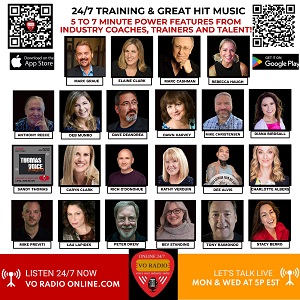|
NONFICTION AUDIOBOOK NARRATION w/r/t $ - Say What? Guidelines For Dealing With Acronyms, Abbreviations and Letters/Symbols May 6, 2016 By Sean Pratt Nonfiction Audiobook Narrator and Coach  One of the big misconceptions about recording a piece of nonfiction is that, like fiction, it’s meant to be a verbatim recitation of the text. One of the big misconceptions about recording a piece of nonfiction is that, like fiction, it’s meant to be a verbatim recitation of the text. It’s not - though it does come close. The reason has to do with the challenge of describing things such as tables, charts, and formulae, as well as dealing with acronyms, abbreviations, and letters/symbols that are specific to the written - not spoken - word. For the reader of the book, these things can be deciphered and understood, but for the listener’s sake, you as the narrator need to take the extra step of "tweaking the text” so that the listener can follow the thread of the author’s intellectual argument. I want to delve into those last three examples (acronyms, abbreviations, and letters/symbols) and offer some advice based on my experience of dealing with them in nonfiction audiobooks. But before I jump in, I want to add that for every instance I list here, there is guaranteed to be at least one, if not several, exceptions. This is the English language - it ain’t written in stone, folks! MEET THESE CRITERIA Please keep in mind, as you read this and then apply these ideas to your narration, that there are two touchstones I use to guide me in altering the text. 1. Author intentionIf the proposed change I want to make satisfies those two criteria, I can feel confident in my choice and move forward. After 20 years and 850+ books, I have rarely had an author, publisher, or producer come back to me and say, "Nope, we want you to do it this other way.” Usually, once I’ve explained my reasoning and purpose in following these guidelines, they are completely onboard with what I’m doing. Of course, if they insist on something different, then they get the final say. So, let’s get started. ACRONYMS Acronyms fall into several categories. Examples such as NATO, FIFA, POTUS, and NAFTA are true acronyms; they are created from the first letters of the phrase (e.g., North Atlantic Treaty Organization). These are also examples of acronyms that are pronounced as words. Ones such as CIA, PDQ, and CD are not words, since we pronounce the letters individually. These are known as initialisms. A hybrid kind, called a pseudo blend, occurs when an acronym has several letters taken out of the full phrase, and the "word” is not created from the first letters of the term (e.g., UNICEF is taken from United Nations Children’s Fund). Acronyms also exist that must be initially spoken to identify their source, because they are used by multiple organizations. You should use the full phrase at least once for the listener to understand what’s what. For example, "the APA” could mean "Audio Producers Association,” "American Psychological Association,” or "Alternate Proficiency Assessment,” just to name a few! WHEN IN DOUBT ... By the way, my first plunge into this confusing world of acronyms happened 20 years ago when I began filming dozens of training films for the government and corporate world. What it taught me was that each of these organizations had their own language and used acronyms in some very idiosyncratic ways. The lesson: when in doubt, research how that particular culture pronounces their acronyms. Do not assume anything! When narrating an acronym, my general preference is to say or spell it according to its origin and use, then state what the letters actually mean. So, I might say,
ABBREVIATIONS I think a little history is required before plunging into the best way of approaching abbreviations in all their various forms and complexities. From the beginning of written text, abbreviations have been used mainly to save space on the page or to save time and money for the typesetter/printer. Fun fact: abbreviations go back even further as a form of rudimentary code used by such ancient civilizations as the Romans and Greeks!Having to write or print the titles "Doctor,” "Mister,” "Honorable,” or "Madame,” just to name a few, repeatedly throughout a text can take up quite a bit of space and time; "Dr.,” "Mr.,” "Hon.,” or "Mme.” work just as well. But even when read, these common abbreviations are converted back into their original form, spelling, and meaning in the reader’s mind. This is important, because if you begin with the premise that readers naturally do this, or that if they’re not familiar with a particular instance they will look it up, then abbreviations by their very nature should be expanded and pronounced accordingly for the listener of an audiobook. ABBREVIATIONS WE KNOW We also encounter longer phrases that mean something other than the symbols used on the page. Latin phrases such as "exempli gratia” or "id est” are not familiar to most modern readers, but their abbreviations, "e.g.” and "i.e.,” respectively, are known. Yet, we don’t think or say to ourselves "e.g.” or "i.e.” when we see them, but their modern translations - "for example” and "that is.” QUICK QUIZ ... Here’s a pop quiz for you: Identify and then give the proper pronunciation of the following 10 abbreviations; then, say them as if you were narrating it in a sentence. For example, "w/r/t” is an abbreviation for (see bold copy):
LETTERS AND SYMBOLS The last variety are letters and symbols such as "Rx” (prescription), "€” (Euros), and "NaCl” (sodium chloride) that are pronounced as something completely different from the letters or symbol used. For example, "The breakthrough came when Marie Curie discovered that NaCl, which is an acronym for sodium chloride, when combined with…” After defining it, I would continue to refer to it as "sodium chloride” and not NaCl, because it’s just easier for the listener to understand. For symbols, on the other hand, I merely state what it means without defining it, because the listener cannot see what I’m referring to. In this example, I would say "354 million Euros”: "During the Great Recession of 2008, Denmark’s economic losses totaled in excess of €354,000,000.”ANOTHER QUIZ ... Time for another pop quiz! Identify and then give the proper pronunciation of the following 10 symbols; then, use them in a sentence.
Recently, I’ve discovered that the symbols for the colon, semi-colon, and dash can sometimes (and I do want to stress the word, sometimes!) be spoken as "which means,” "which is,” "which was,” "which are,” "namely,” or "specifically,” among several options. I will occasionally use the phrase instead of the implied "pregnant pause” in order to clarify the second half of the sentence for the listener and keep the flow of the narration moving forward. For example:
In closing, remember to apply those two touchstones when deciding when and how to alter the text:
-------------------- ABOUT SEAN Sean Pratt has been a working actor for over 30 years. He has been an audiobook narrator for 20 years, recording over 850 books in almost every genre, and has received eight AudioFile Magazine "Earphones” awards and 5 "Audie” nominations from the Audio Publishers Association. Currently, Sean mentors performers on audiobook narration technique, as well as teaching classes on and writing articles about the Business of the Biz. Web: www.seanprattpresents.com |
|
|
On Michael Langsner's Voice-Over Roadmap Podcast
For essential voice-over business strategies
With Sean Daeley and Paul Stefano - check it out!
Get your bi-weekly dose here ... all things VO!
As of the NEW website launch, 03/22/2012










Thanks for writing it, Sean!
Thanks again.
"A simple interest roll-up rate that is at least the Monthly 10-year Treasury constant maturity rate (Note 25) plus 3% for the first 15 years, or until your initial lifetime withdrawal, whichever comes first."
"Note 25: As published by the Board of Governors of the Federal Reserve System. The roll-up rate has a minimum of 5% and a maximum of 10%, rounded up or down to the nearest 0.25%. The roll-up rate will always be determined one year in advance."
When I came to (Note 25) in the first sentence, I read the first sentence in Note 25. Then, after completing the first paragraph, I read the rest of Note 25. In this case, I knew the author's goal and intention was listener comprehension.
Namaste, Linda